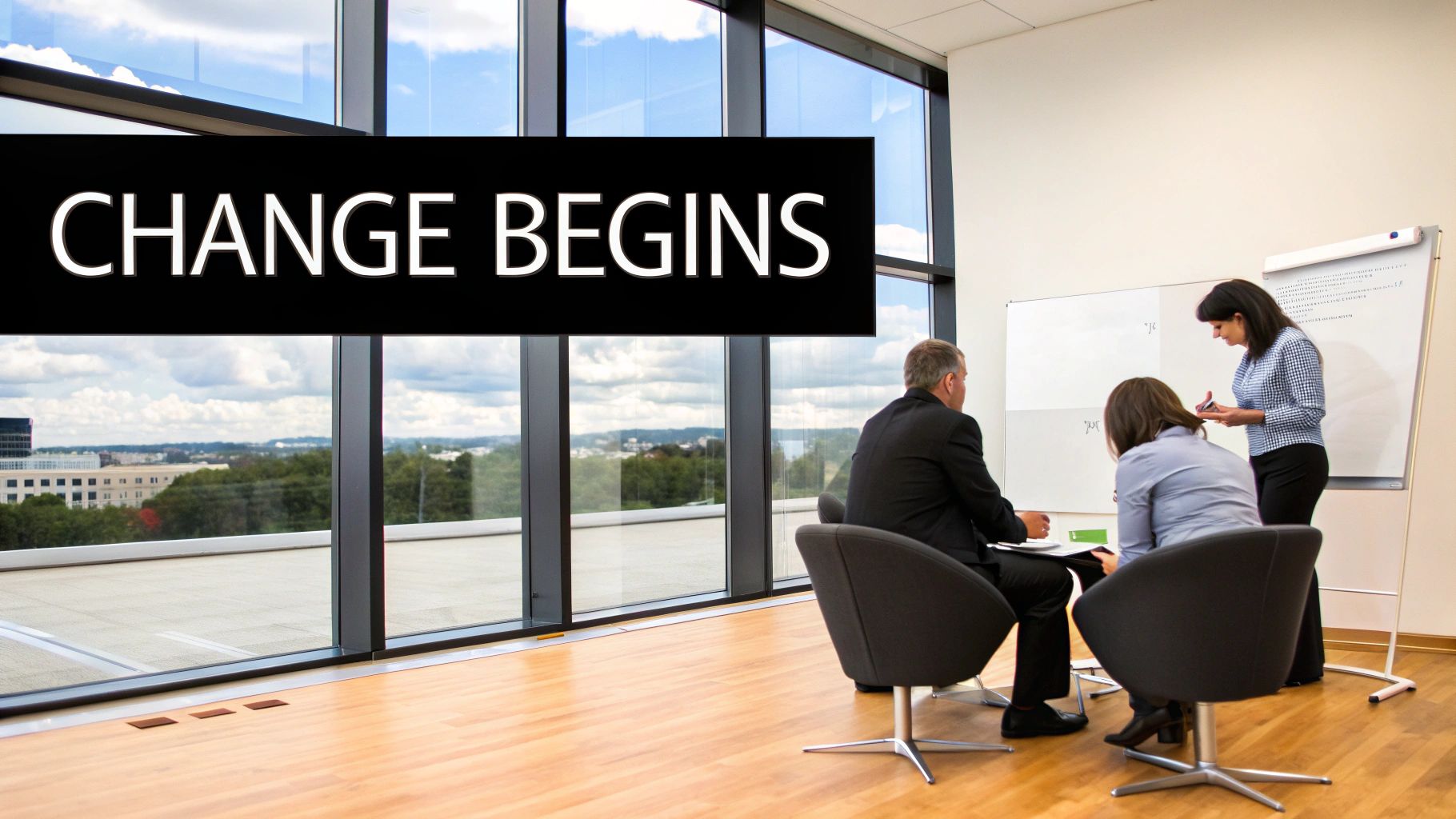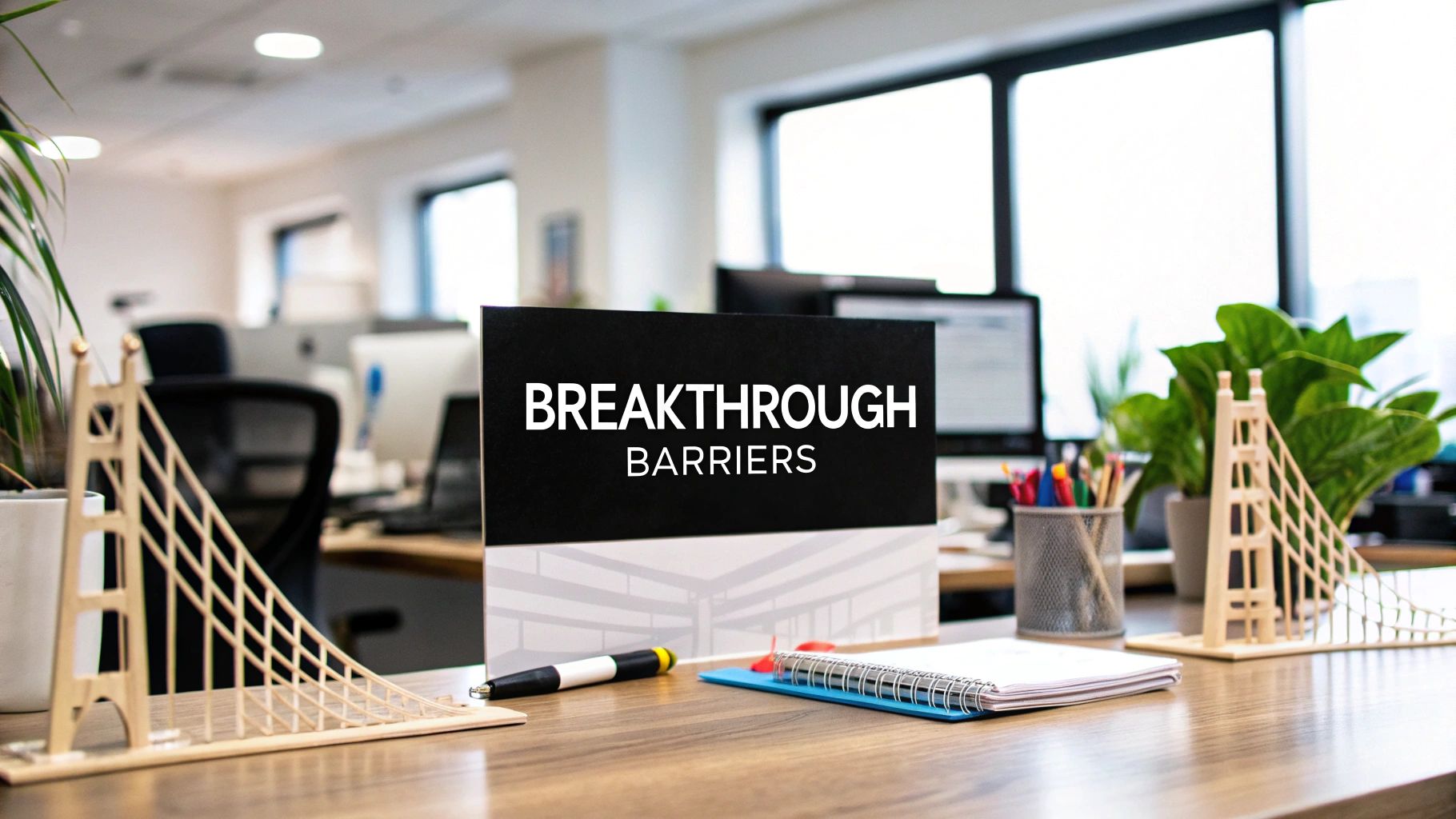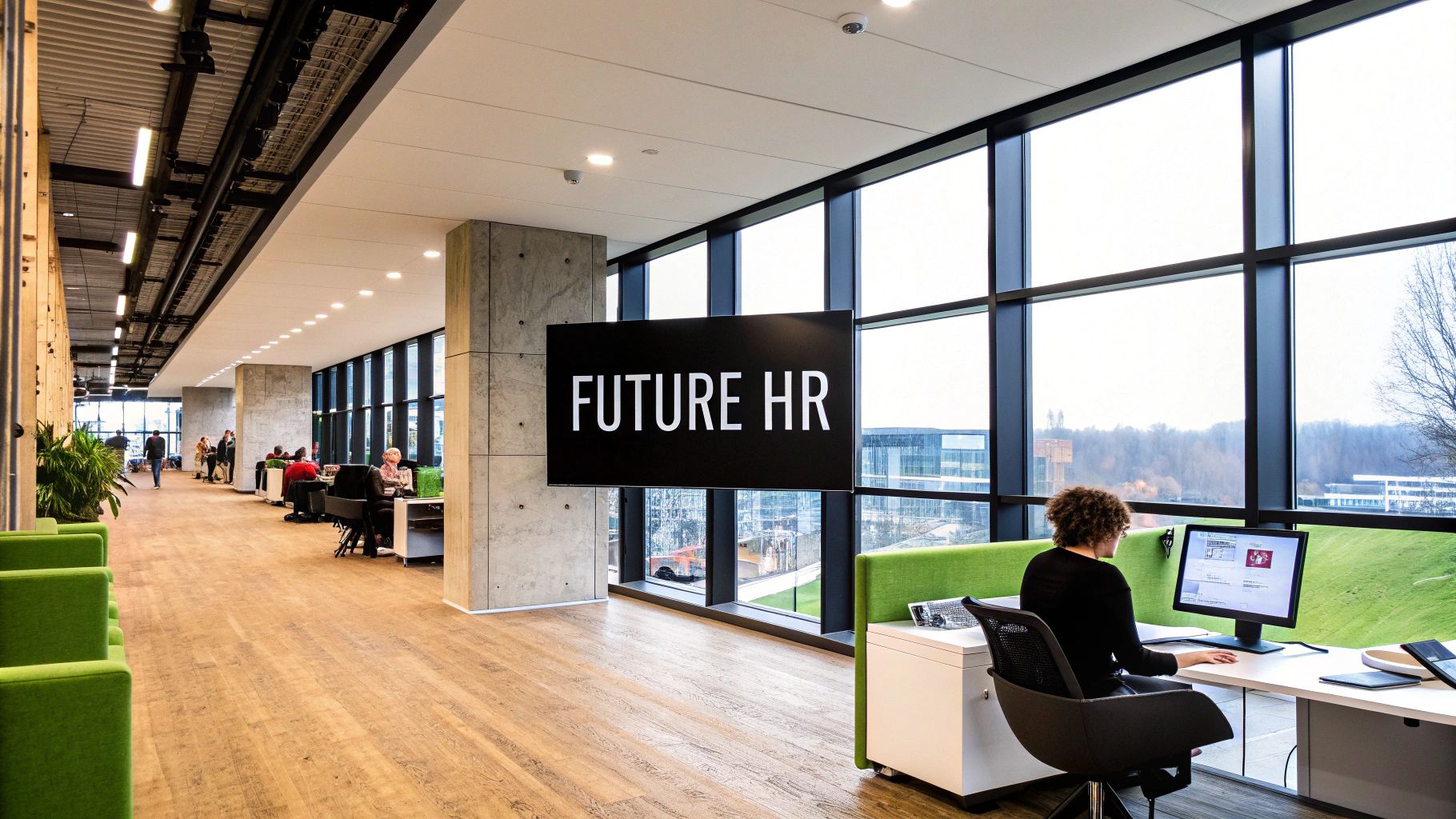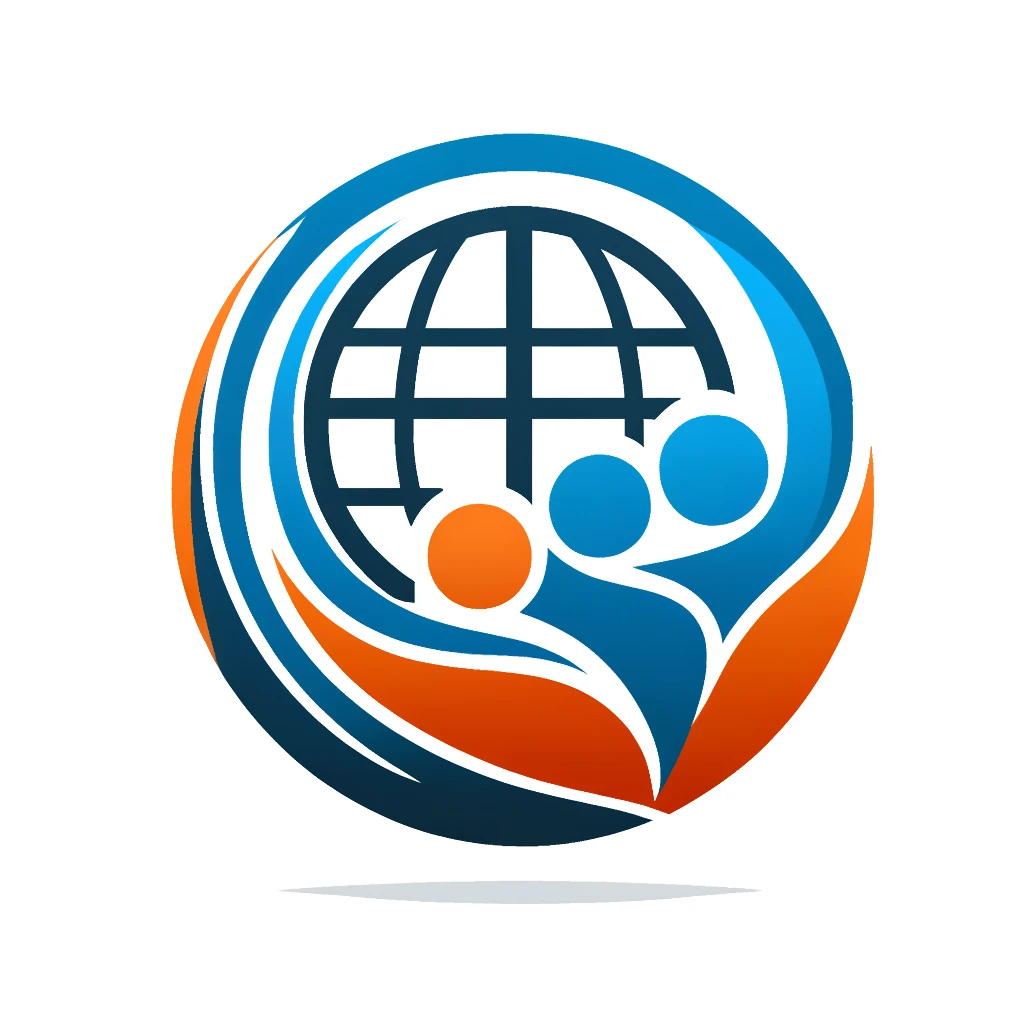The Strategic Evolution of Change Management in HR

Change management in HR has undergone a remarkable transformation. It's no longer a behind-the-scenes function but a crucial engine driving organizational success. This shift positions HR professionals at the very center of transformations, acting as a vital bridge connecting people and strategy.
This unique vantage point empowers HR to take on key roles in navigating change initiatives, impacting everything from employee morale and satisfaction to the overall performance of the business. This evolution underscores the increasing need for HR to craft strategies that cultivate a culture of adaptability and resilience throughout the organization.
One of the key factors highlighting the importance of change management in HR is the historically high failure rate of change initiatives. Roughly 70% of these initiatives fall short of their goals, often due to initial employee resistance. This emphasizes the essential role of clear communication and authentic employee engagement during periods of transition. More in-depth statistics can be found here: Change Management Statistics
The Expanding Role of HR in Change
This strategic shift necessitates that HR move beyond traditional administrative tasks. HR must now spearhead the efforts in shaping organizational culture and behavior during times of change.
For instance, HR professionals are now more deeply involved in crafting and implementing communication strategies. They are providing training and development programs specifically tailored to the change. They are actively managing employee feedback throughout the entire process.
This broader role equips HR to directly influence the employee experience during transformations, thereby boosting the probability of achieving successful outcomes.
From Reactive to Proactive: Anticipating Change
Today's HR professional must anticipate future changes and proactively prepare the workforce. This forward-thinking approach requires HR to analyze industry trends, assess potential disruptions, and develop strategies to minimize risks.
Furthermore, HR can nurture a culture of continuous learning and development, providing employees with the skills and adaptability they need to embrace change effectively. This shift from reactive to proactive change management is paramount for organizations seeking to thrive in today's ever-changing business world.
Building Organizational Resilience Through Change
Effective change management in HR isn't solely about managing individual transitions; it's about building organizational resilience. By encouraging open communication, establishing support systems, and empowering employees to actively participate in the change process, HR can create a more adaptable and resilient organization.
This means HR has a vital role to play in strengthening the organization’s ability to not only weather change but to flourish because of it. This focus on resilience is a cornerstone of the strategic evolution of change management within HR.
Why HR-Led Change Initiatives Stumble: Honest Truths
Successfully navigating change within any organization is challenging. HR professionals often lead these initiatives, guiding their companies toward a better future. But even with the best intentions, HR-led change can sometimes fall short. Understanding why is the first step to creating strategies that truly deliver.
Common Pitfalls in HR Change Management
Several common obstacles make change implementation difficult. Communication breakdowns are a major culprit. When information isn't shared clearly and consistently, employees can become confused and mistrustful. This can lead to resistance, undermining the entire initiative.
Another frequent issue is stakeholder misalignment. Senior leaders, middle management, and employees must all be on the same page about the change's purpose and objectives. Without this shared vision, it's hard to gain the necessary momentum.
Inadequate resources can also significantly hinder change efforts. This could mean insufficient budget, lack of dedicated staff, or a shortage of training opportunities. Even well-planned initiatives can struggle without proper support.
Finally, psychological factors play a key role in how employees react to change. People may fear the unknown, feel uncertain about their future roles, or resist disrupting familiar routines. Ignoring these feelings is a common mistake.
To illustrate this point, research shows that only 25% of employees feel their organization's senior leaders effectively manage change. This underscores the need for leadership buy-in and active participation to cultivate a positive change environment. More detailed statistics can be found here: Change Management Statistics
Let's take a deeper look at the typical barriers organizations face, as revealed by industry research and case studies.
Understanding these barriers is crucial for crafting effective mitigation strategies. The following table provides a framework for navigating these challenges.
Top Barriers to Successful Change Implementation
| Barrier Type | Frequency | Impact Level | Mitigation Strategy |
|---|---|---|---|
| Communication Breakdowns | High | High | Implement a robust communication plan, including regular updates, feedback mechanisms, and clear channels for addressing employee concerns. |
| Stakeholder Misalignment | Medium | High | Facilitate workshops and meetings to align key stakeholders on the change vision, goals, and individual roles. |
| Inadequate Resources | Medium | Medium | Develop a comprehensive resource allocation plan, securing necessary budget, personnel, and training to support the initiative. |
| Psychological Resistance | High | High | Provide emotional support, address employee anxieties through open dialogue, and offer training to help individuals adapt to new processes and roles. |
This table highlights the interconnectedness of these barriers and the importance of a comprehensive approach to mitigation. By addressing each challenge strategically, HR can pave the way for smoother transitions.
Overcoming Challenges: A Proactive Approach
Addressing these challenges requires a proactive, multifaceted strategy. HR should prioritize clear, consistent communication throughout the entire change process, keeping all stakeholders informed and engaged.
Building a strong coalition of change champions across the organization can also help drive buy-in and facilitate communication. These individuals can act as ambassadors for the change, promoting its benefits and addressing concerns within their teams.
Securing adequate resources is essential. HR needs to advocate for the necessary budget, personnel, and training to support the change initiative effectively. This includes not only financial resources but also the time and expertise required to manage the transition smoothly.
Finally, acknowledging and addressing the psychological aspects of change is paramount. This involves providing support, creating opportunities for open dialogue, and helping employees navigate the emotional transitions that accompany organizational change. By proactively addressing these factors, HR can dramatically increase the chances of a successful change initiative, creating a more positive and adaptable organizational culture.
Building Your HR Change Management Playbook

Now that we've explored the typical stumbling blocks in change initiatives, let's create a practical framework for navigating change management in HR. This involves designing a structured approach that covers the entire change lifecycle. Think of it as your change management playbook, a guide to help you confidently lead your team through transitions.
Assessing the Landscape: Understanding the Need for Change
The first step in building your playbook is understanding your organization's specific needs. This means assessing the current situation, identifying pain points, and defining what you want the future to look like. Are you implementing a new HR system? Restructuring teams? Perhaps you’re working towards a positive shift in company culture. Each scenario calls for a tailored approach. This initial assessment lays the groundwork for a targeted and effective change management strategy.
The Planning Stage: Mapping Out Your Strategy
Once you clearly understand the change needed, you can move into the planning phase. Here, you'll define your objectives, identify key stakeholders, and create a detailed implementation plan. It’s also vital to anticipate potential resistance and develop strategies to soften its impact. This includes choosing the right communication channels and preparing helpful training materials. Thorough planning is key. As of 2024, a striking 73% of organizations expect to increase their change initiatives. This highlights the growing need for robust change management practices within HR. For more insights, delve into these Change Management Statistics.
Implementation: Putting Your Plan into Action
The implementation phase brings your carefully crafted plan to life. This stage requires thoughtful coordination, open communication, and continual monitoring. Regular updates to stakeholders, consistent opportunities for feedback, and quick responses to concerns are essential for keeping the process on track. This active management ensures the change progresses smoothly and any emerging challenges are addressed efficiently.
Evaluation and Measurement: Tracking Your Success
Finally, evaluating the impact of your change management efforts is crucial. This involves measuring your progress against your initial objectives and identifying any areas for improvement. Consider gathering employee feedback, tracking adoption rates of new systems, or noting changes in productivity. This valuable data helps you refine your playbook and ensure future change initiatives are even more impactful.
Bringing it All Together: Your Customized HR Playbook
As you develop your playbook, keep these important aspects in mind:
-
Stakeholder Mapping: Identify key individuals and groups affected by the change, then tailor your communication accordingly.
-
Communication Planning: A solid communication plan details what information will be shared, when, how, and with whom.
-
Training Development: Create focused training programs that empower employees with the skills and knowledge they need.
-
Resistance Management: Proactively address resistance by understanding its root causes and implementing strategies to lessen any negative impact.
Remember, your change management playbook is a dynamic tool, adaptable to the specific context of each initiative and your organization's evolving needs. By incorporating these principles, you can steer successful transformations and foster a more agile and resilient organization.
Cultivating Change Champions Across Your Organization
Real, lasting change within an organization takes more than a well-crafted plan. It requires dedicated individuals at every level, ready to embrace and drive that change forward. These individuals are your change champions, and they are essential to successful change management in HR. This section explores how HR can identify, develop, and empower these key players to lead transformative initiatives.
Identifying Your Change Champions
Who are these change champions? They are the individuals within your company who actively advocate for and support change. They influence their peers through their respected opinions and possess a genuine enthusiasm for new initiatives. They don’t necessarily need to be in leadership roles, but they do need to be passionate and engaged. Identifying these individuals is the crucial first step. HR can achieve this through several methods: by observing employee engagement during existing initiatives, by gathering recommendations from team leaders, or by conducting internal surveys. These champions become the vital force behind the change process, building momentum and addressing any resistance along the way.
Developing Key Competencies for Change Leaders
Once potential change champions are identified, HR can help them develop the necessary competencies that make leaders truly effective during periods of transition. Emotional intelligence is crucial, enabling champions to navigate the complex emotional landscape that often accompanies significant change. Strong communication strategies are equally important. Champions need to clearly and effectively communicate the reasons for the change, highlighting the benefits for everyone involved. Resilience is also essential, as setbacks are inevitable. Change champions must persevere through challenges and maintain a positive outlook, inspiring others to do the same. Finally, adaptive decision-making allows champions to navigate the uncertainties inherent in change, adjusting their approach as needed to achieve the desired outcomes.
Empowering Change Champions Through Leadership Development
HR can implement targeted leadership development programs specifically designed to nurture these vital skills in change champions. These programs could include workshops on effective communication techniques, personalized coaching sessions focusing on emotional intelligence, or targeted training on addressing resistance to change. Here are some practical steps to consider:
-
Create Workshops: Focus on practical skills like effective communication, conflict resolution, and collaborative problem-solving.
-
Offer Individual Coaching: Provide personalized support tailored to each champion's unique strengths and development needs.
-
Establish Mentoring Programs: Pair experienced change leaders with newer champions to provide guidance, support, and valuable insights.
By providing these resources and development opportunities, HR equips change champions with the tools they need to lead effectively, inspiring others and driving positive change throughout the organization.
Supporting Change Champions Through Challenges
Change is rarely a smooth, straightforward process. Challenges will inevitably arise, and it's HR's role to provide ongoing support to help change champions navigate these difficulties. This might involve offering access to helpful resources, facilitating regular check-in meetings, or creating a dedicated forum where champions can share their experiences and exchange best practices. Specifically, providing tools and training on recognizing and addressing resistance patterns can be invaluable when obstacles emerge. Consistent support ensures change champions feel empowered and equipped to drive the change initiative forward, even in the face of adversity. By investing in developing and supporting these individuals, HR significantly enhances the likelihood of success for any change management initiative.
Crafting Communication That Drives Change Acceptance

Effective communication is the cornerstone of successful change management in HR. It’s about fostering understanding, building trust, and inspiring action. It's a journey of bringing everyone on board, ensuring they feel heard and valued throughout the process. This section explores how to design and implement change communication that resonates with your employees and motivates them to embrace change.
Understanding How Employees Process Change
Employees process change through their own unique perspectives. Their past experiences, current anxieties, and personal perceptions all play a role. This means HR must tailor communication to address these individual and collective concerns. Clearly articulating the "why" behind the change is crucial.
Emphasizing the benefits for both the organization and employees can significantly reduce uncertainty and increase buy-in. Acknowledging potential challenges and providing support resources builds a sense of psychological safety, encouraging employees to navigate the transition with confidence.
Selecting the Right Communication Channels
Choosing the right communication channels is essential. Different channels serve different purposes. A company-wide email might be suitable for initial announcements. Smaller team meetings, however, are better for in-depth discussions and addressing specific concerns.
Over-reliance on email can lead to misinterpretations and missed opportunities for real dialogue. HR should consider a blend of channels. Intranet posts, interactive webinars, and even informal Q&A sessions can create a more engaging and multi-faceted communication experience.
Sequencing Messages for Maximum Impact
The order you present information matters. Start with clear, concise messages that outline the overall change vision. This sets the stage for subsequent, more detailed announcements.
Following the initial vision statement with information about specific process changes allows employees to digest information gradually. They can then connect individual changes to the broader organizational goals. This strategic sequencing prevents information overload and promotes better understanding.
Establishing Meaningful Feedback Mechanisms
Effective change communication is a two-way process. Feedback is essential for understanding employee perspectives, addressing concerns, and making necessary adjustments.
Surveys, focus groups, and even suggestion boxes can provide valuable insights. Actively listening to employee voices and incorporating their feedback builds a sense of shared ownership. Regularly sharing feedback summaries and demonstrating how this input influenced decisions promotes transparency and reinforces the importance of employee contributions.
Storytelling and Change Narratives
Storytelling is a powerful tool. Crafting compelling narratives that illustrate the benefits of change can personalize the message, making it more relatable and inspiring. Sharing success stories from early adopters demonstrates the positive impact of the change, motivating others to embrace it. This approach brings facts and figures to life, creating a more engaging and impactful communication experience.
Case Studies: Communicating Through Complex Changes
Learning from other organizations provides invaluable lessons. During a merger, for example, open and honest communication about the process, the rationale, and the potential impacts on employees is crucial for maintaining morale and productivity. Similarly, during a major digital transformation, communicating the benefits of new technologies and offering ample training opportunities can smooth the transition. These case studies highlight the importance of tailored communication strategies. Addressing the specific needs of each stakeholder group is fundamental for driving change acceptance and achieving a successful outcome.
To further assist in planning your communication strategy, consider the following table:
This table provides a structured approach to tailoring change communications based on different stakeholder groups and stages in the change management process.
Change Communication Matrix by Audience and Phase
| Stakeholder Group | Pre-Change Phase | Implementation Phase | Stabilization Phase | Key Messages |
|---|---|---|---|---|
| Senior Leaders | Vision and strategic rationale for change | Progress updates, key decisions, and addressing roadblocks | Celebrating successes, reinforcing long-term vision | Emphasis on strategic alignment, long-term benefits, and return on investment |
| Middle Management | Context for change and their role in cascading information | Specific instructions, training, and resources to support teams | Ongoing support and addressing emerging challenges | Focus on their role in leading teams through change and providing clear expectations |
| Front-Line Employees | Clear explanation of the change and how it impacts them | Practical guidance, hands-on training, and support resources | Reinforcement of new processes and celebrating achievements | Focus on practical implications, benefits to their daily work, and addressing concerns |
By utilizing this matrix, you can ensure that the right messages reach the right audience at the right time, maximizing the effectiveness of your change communication plan. Remember, successful change is a collective effort, and effective communication paves the way for shared understanding and ultimately, successful outcomes.
Measuring What Matters in HR Change Management
How do you know if your change management efforts are truly making a difference? It's not about superficial metrics, but about understanding the real impact on your people and your organization. This section explores meaningful ways to measure the effectiveness of change management in HR, going beyond surface-level observations to gain actionable insights. We'll explore both quantitative and qualitative approaches, offering practical strategies for tracking progress, adapting to challenges, and ultimately, ensuring your change initiatives create lasting positive change.
Quantitative Measurement: Tracking the Tangible
Numbers provide a clear picture of progress. Quantitative measurements offer objective data points to track how change is impacting key areas. For example, tracking adoption rates of new systems shows how quickly and completely employees are embracing new technologies and processes. This data can offer valuable insight into the effectiveness of your training and communication strategies.
Measuring the impact on productivity reveals the tangible outcomes of change. This could involve analyzing metrics like output per employee, project completion rates, or even customer satisfaction, depending on the specific change implemented. These hard numbers demonstrate the real-world effects of your initiatives.
Calculating the return on investment (ROI) for HR initiatives proves the financial value of your efforts. By comparing the costs of implementing the change with the resulting cost savings or revenue gains, you can demonstrate the tangible financial benefits of effective change management.
Qualitative Measurement: Understanding the Human Element
While numbers are important, they don't tell the whole story. Qualitative measurements provide a deeper understanding of how employees are experiencing the change. Employee sentiment analysis, gathered through surveys, interviews, and focus groups, uncovers how employees feel about the changes. This valuable context enriches the quantitative data and reveals underlying issues influencing acceptance or resistance.
For example, if adoption rates are low, sentiment analysis can reveal whether this is due to inadequate training, unclear communication, or genuine concerns about the new way of working. Understanding these nuances allows you to address the root causes of challenges and tailor your approach for greater success.
Establishing Baselines and Tracking Progress
To accurately measure the effectiveness of your change management initiatives, establish clear baselines before implementing any changes. This involves collecting initial data on the metrics you plan to track, creating a benchmark against which to measure future progress and assess the true impact of the change. This initial snapshot provides essential context for understanding the transformation that unfolds.
Just like a "before" photo in a home renovation, a baseline allows you to see the tangible improvements and demonstrate the value of your efforts. This data also provides invaluable insights for future change initiatives, setting the stage for continuous improvement.
Creating Effective Dashboards and Communicating Progress
Sharing progress with stakeholders is essential for maintaining momentum and securing buy-in. A well-designed dashboard visually communicates key metrics, showcasing successes and highlighting areas for improvement. This clear visual representation makes the data easily digestible and actionable.
Dashboards can also serve as early warning systems. For example, a dip in employee satisfaction or a slowdown in adoption rates can signal a need for intervention. This allows you to address emerging issues proactively and keep the change initiative on track.
Post-Implementation Reviews: Capturing Lessons Learned
After the change is implemented, a thorough post-implementation review is vital. This involves gathering feedback from all stakeholders, analyzing both quantitative and qualitative data, and identifying key lessons learned. This process isn't just about reflection; it's a critical step in continuous improvement. The insights gleaned from this review will inform future change initiatives, refining your approach and increasing the likelihood of future success. This creates a cycle of continuous improvement, ensuring that each change initiative builds upon the experience of the last. By embracing these measurement strategies, you can transform change management from a process of uncertainty into a powerful engine for growth and positive change within your organization.
The Future of Change Management in HR: New Frontiers

The HR world is in constant motion, and change management is no exception. This exploration delves into the exciting new trends and technologies transforming how HR professionals guide their organizations through periods of transition. We'll uncover how these advancements pave the way for more effective and personalized change management strategies.
The Rise of Data and AI in Change Management
Data analytics and artificial intelligence (AI) are becoming indispensable tools for change management. By analyzing extensive datasets, these tools can reveal hidden patterns and predict potential areas of resistance. This empowers HR to address concerns proactively and craft communication strategies tailored to specific employee groups.
Imagine using AI-powered sentiment analysis to identify employees struggling with a new system. HR can then offer personalized support, smoothing the transition. Furthermore, data analytics can measure the effectiveness of change initiatives, driving continuous improvement and maximizing positive impact.
Embracing Agile Methodologies in HR
Agile methodologies, born from the world of software development, are now making waves in HR change management. This iterative approach prioritizes flexibility and adaptability. Short cycles of planning, implementation, and feedback allow for rapid adjustments based on real-time data.
This agility is invaluable in today's dynamic business environment where change is a constant. By embracing agile principles, HR can ensure that change initiatives stay aligned with evolving business needs, maximizing their effectiveness and minimizing disruption.
From Project-Based to Continuous Change
The old model of project-based change management is evolving into a model of continuous change. This shift reflects the reality of today's ever-changing business world. Change is no longer a one-time event, but an ongoing process.
This requires HR to cultivate a culture of adaptability and resilience. By fostering a mindset of continuous learning and improvement, HR can empower employees to embrace change as an integral part of their work experience, creating a more agile and responsive organization.
The Changing Expectations of Employees
Employee expectations around change are also transforming. They want to be active participants, not passive recipients. This means HR must create opportunities for employees to share their ideas and feedback throughout the change process.
This participatory approach fosters a sense of ownership and significantly increases the likelihood of successful implementation. Consider establishing employee feedback forums or creating collaborative working groups dedicated to specific change initiatives to empower your workforce.
Navigating Change in Remote and Hybrid Environments
The rise of remote and hybrid work presents unique challenges and exciting opportunities for change management. Communicating effectively with a dispersed workforce requires thoughtful planning and the use of diverse channels.
Digital tools can play a vital role in enhancing collaboration and feedback collection during change initiatives. By strategically leveraging these technologies, HR can ensure that remote and hybrid employees feel connected, informed, and supported throughout the entire process.
Preparing for the Future of Change Management
To thrive in this evolving landscape, HR professionals should prioritize developing these key competencies:
- Data literacy: The ability to collect, analyze, and interpret data to inform change strategies.
- Technological proficiency: Mastering digital tools and platforms for communication, collaboration, and data analysis.
- Adaptability and resilience: Embracing change and developing effective management strategies.
- Empathy and communication: Understanding employee perspectives and communicating change with clarity and compassion.
By cultivating these skills and embracing new frontiers, HR professionals can confidently lead their organizations through future challenges and opportunities. The future of change management is dynamic, and HR is at the forefront, driving positive transformation and shaping the future of work. Are you ready to embrace the future of HR and lead the charge in change management? The Global Human Resource Institute offers a variety of courses and certifications to equip you with the skills you need. Visit their website to learn more and advance your HR career.




0 Comments